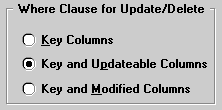Sometimes multiple users access the same tables at the same time. In this type of situation, you need to decide when to allow your application to update the database. If you allow your application to always update the database, it could overwrite changes made by other users.
Figure 20-4: Controlling when updates succeed

You can control when updates succeed by specifying which columns PocketBuilder includes in the WHERE clause in the UPDATE or DELETE statement used to update the database:
UPDATE table... SET column = newvalue WHERE col1 = value1 AND col2 = value2 ... DELETE FROM table WHERE col1 = value1 AND col2 = value2 ...
SQL Anywhere lets you create special timestamp columns so that you can ensure that users are working with the most current data. If the SELECT statement for the DataWindow object contains a timestamp column, PocketBuilder includes the key column and the timestamp column in the WHERE clause for an UPDATE or DELETE statement regardless of which columns you specify in the Where Clause for Update/Delete box.
If the value in the timestamp column changes (possibly because another user modifies the row), the update fails.
Choose one of the options in Table 20-1 in the Where Clause for Update/Delete box. The results are illustrated by an example following the table.
Consider this situation: a DataWindow object is updating the Employee table, whose key is Emp_ID; all columns in the table are updatable. If the user changes the salary of employee 1001 from $50,000 to $65,000, this is what happens with the different settings for the WHERE clause columns:
If you selected the Key Columns option for the WHERE clause, the UPDATE statement looks like this:
UPDATE Employee SET Salary = 65000 WHERE Emp_ID = 1001
This statement will succeed whether or not other users have modified the row since your application retrieved it. For example, if another user has modified the salary to $70,000, that change will be overwritten when your application updates the database.
If you selected Key and Modified Columns for the WHERE clause, the UPDATE statement looks like this:
UPDATE Employee SET Salary = 65000 WHERE Emp_ID = 1001 AND Salary = 50000
Here the UPDATE statement also checks the original value of the modified column in the WHERE clause. The statement will fail if another user has changed the salary of employee 1001 since your application retrieved the row.
If you selected Key and Updatable Columns for the WHERE clause, the UPDATE statement looks like this:
UPDATE Employee SET Salary = 65000 WHERE Emp_ID = 1001 AND Salary = 50000 AND Emp_Fname = original_value AND Emp_Lname = original_value AND Status = original_value ...
Here the UPDATE statement checks all updatable columns in the WHERE clause. This statement will fail if any of the updatable columns for employee 1001 have been changed since your application retrieved the row.